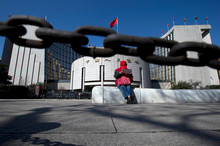Jul 3, 2013

We still don’t know whether the freeze-up of China’s interbank market last week was a hiccup or a foreshock.
Regardless, it is symptomatic of something that may be awry in or around China’s financial system.
Most think the problem is commercial bank-lending to shadow bankers who are packaging high-risk wealth management products which are then sold to commercial banks and their clients.
However, Joe Zhang, a highly regarded former UBS analyst and banker now in micro-finance, has a different view.
He argues that the problem is financial repression, specifically the capping of official interest rates at artificially low levels, which encourages speculative investment while fuelling inflation and the wealth gap.
Some of Zhang’s data is daunting.
From 1986 to 2012, nominal Chinese GDP grew 16 per cent annually, bank loans 18 per cent and the money supply (M2) 21 per cent.
A similar gap between GDP and M2 even appears if the beginning year is moved to 2000.
Zhang believes the growth of credit, and the money supply in excess of GDP, drives an inflationary spiral largely covered over in China’s official statistics.
His solution is to allow interest rates to rise to market rates, which would curb inflation and speculative investment – and depress nominal GDP growth.
The latter is the rub because China remains hooked on GDP.
These targets are chased at four levels of government – national, provincial, municipal or prefectural, and district or county.
Results are reported semi-annually and can make headline news. Most importantly, advancement of Chinese government officials to higher office may depend on local GDP growth.
GDP is the sum of consumption (private and government), investment and net exports (exports minus imports).
In developed countries, consumption is by far the largest component of GDP, often 60 to 70 per cent, but in China investment is the largest component – as much as 50 per cent of GDP.
Some argue that China remains under-provisioned in infrastructure and still requires extraordinary levels of investment.
The IMF disagrees and a recent working paper states that Chinese over-investment is 12 to 20 per cent of GDP.
This means that much of Chinese investment is unproductive and will ultimately prove a drag on growth.
What motivates all this investment? Some say it is corruption – investment funds going into the pockets of politicians and their families.
However, I think the motivation for over-investment lies in the nature of state capitalism.
Many academic colleagues admire China’s brand of state capitalism – after all, look at China’s growth and infrastructure development.
That is precisely the point. A former State Council official under Zhu Rongji put it this way: growth is hard-wired into the Chinese system.
Think about it. In any country you can borrow a dollar from the bank, invest it in a project and increase GDP by one dollar, whether or not the project proves a good investment.
Most people want to make good investments, because they and their lenders are concerned with the return on the dollar rather than the dollar increment in GDP.
In China, by contrast, government officials more concerned with incremental GDP than return on investment may be inclined to go along with projects of uncertain economic value, since even bad investments contribute to GDP.
Short-term, the results will look good.
The RMB4 trillion ($835 billion) stimulus package announced in 2008 helped China cushion the global economic tsunami. Long term, however, it is a downward spiral. As fixed assets pile up, returns plummet.
The most recent figures from the National Bureau of Statistics show that the January-May 2013 core business profits of state-owned enterprises (the principal beneficiaries of over-investment) increased a paltry 2.2 per cent compared to 2012.
A similar dynamic operates in the private sector when the same local officials accountable for local GDP are also charged with promoting favoured technologies.
The solar photovoltaic industry, singled out for rapid development in China’s 12th five-year economic plan, is today flooded with over-capacity, and is in disarray in China and globally.
Is there a better form of state capitalism?
Frankly, I don’t know. Joe Zhang has a point: market (read higher) interest rates would direct investment to more productive uses.
Still, China remains a developmental state where economic growth, measured by GDP, takes precedence over profits and – nearly unique to China – there is intense regional competition for growth.
Maybe it was a good idea for the People’s Bank to signal that it is time to throw the brakes on investment-driven growth. But maybe it wasn’t given the abrupt about-face.
My own feeling is that it may be time for Capitalism 101 where firms, not the state, drive economic growth the old-fashioned way by attracting customers and profits, and hence retained earnings and investment that will grow the enterprise – and the Chinese economy.
Professor Marshall Meyer from the University of Pennsylvania Wharton School will speak at the University of Auckland Business School on July 24 as part of the New Zealand Asia Institute’s Asia Dialogue.
